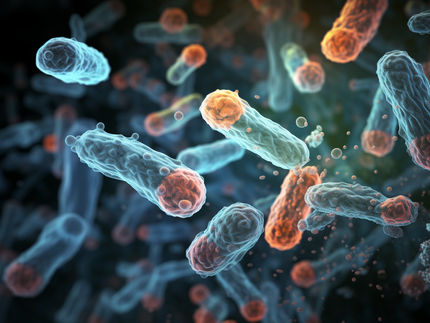Antibiotic Resistance Distributed via River System
Scientific Team Identifies Biofilm in the River as a Possible Reservoir of Resistance
Two new scientific studies to understand the spread of antibiotic resistance (ABR) along the Danube have produced important key findings: biofilms present in the river may be better indicators than the water itself of the entry of antibiotic-resistant bacteria from clinical facilities and wastewater. In addition, a new investigative concept – combining molecular genetic methods for ABR detection with modern diagnostics for faecal pollution and key environmental and chemical parameters – has shown that human faecal contamination is the main source of ABR along the entire Danube. The new approach allows the spatio-temporal dynamics of ABR in rivers to be recorded, hotspots to be identified and the main drivers of ABR to be determined.
Every year, thousands of people in Europe die from infections caused by antibiotic-resistant bacteria. These are alarming figures, partly due to the development of resistance caused by the overuse of antibiotics in medicine and agriculture. Globally, the ‘clinical environment’ (e.g. hospitals) is considered to be the main hotspot for the spread and development of ABR, as this is where antibiotic-resistant bacteria or their genes are exchanged between patients. Clinical wastewater enters natural aquatic ecosystems via sewage treatment plants, allowing ABR bacteria to enter rivers and lakes. There they are not only found in the water itself, but also in biofilms – communities of microorganisms that adhere to solid surfaces in the water, such as rocks, plants or sediments, producing a common layer of mucus (extracellular matrix) and thus form a stable “film”.
Resistance Patterns of E. coli in Human and River Samples
In one of the current studies, the research team analysed the resistance patterns of the bacterium Escherichia coli in human isolates and environmental samples from the Danube (water and biofilm) with partners from the University Hospital St. Pölten (Prim. Dr. Barbara Ströbele, Dr. Ildiko Pap), teaching and research site of KL Krems, and the Medical University of Graz (Doz. Dr. Gernot Zarfel). Prof. Andreas Farnleitner, Head of the ICC Water and Health at KL Krems and TU Vienna, explains: „E. coli is a very suitable model organism for this: it is widespread as the main pathogen of urinary tract infections, often colonises leaking urinary catheters of hospital patients, is used in water as an indicator of ABR and is recommended by the WHO as an indicator of antibiotic resistance. In total, we analysed 697 patient, 489 water and 440 biofilm isolates for their sensitivity to 20 antibiotics and thus obtained resistance patterns.” Overall, the results indicated a rather moderate resistance situation in Austria: despite significantly higher resistance levels in the human isolates compared to the river samples, only few resistances to common reserve antibiotics such as meropenem and tigecycline – drugs that are only used when first-line therapy is ineffective – were found. Although there were no major differences in resistance between water and biofilm samples, some bacterial isolates were found in the biofilm that were resistant to certain critical antibiotics and even carried ESBL genes. ESBL stands for “extended-spectrum beta-lactamase” and means that these bacteria produce enzymes that are resistant to many beta-lactam antibiotics, which makes the treatment of infections more difficult. The biofilm may therefore be a better indicator of the influence of clinical environments on ABR in rivers than the water itself.
A Comprehensive Understanding of the ABR Along 2,300 km of the Danube River
Large rivers are particularly critical ecosystems for the global distribution of ABR in the environment because they can be heavily affected by wastewater pollution and at the same time represent vital lifelines that fulfil various human needs. However, a comprehensive understanding of the occurrence, distribution and main drivers of ABR along entire river courses has so far been largely lacking – a fact that the researchers addressed in the other study for the Danube. They chose a holistic approach by analysing spatio-temporal patterns and hotspots of antibiotic-resistant genes (ARGs) along 2,311 km of the navigable Danube river and combining a longitudinal and temporal surveillance campaign. Prof Alexander Kirschner, researcher at MedUni Vienna, Karl Landsteiner University Krems and deputy head of the ICC, comments: “The extensive expertise gained in this way forms the basis for targeted management to reduce the spread of ABR in river basins. We are presenting the first in-depth ARG dataset along the Danube, which will help to assess future trends.” To improve the understanding of the distribution and dynamics of ABR, ABR should also be investigated in other environmental compartments – such as river biofilms or sediments – as these could serve as long-term reservoirs.
Original publication
Melanie Leopold, Angelika Kabicher, Ildiko-Julia Pap, Barbara Ströbele, Gernot Zarfel, Andreas H. Farnleitner, Alexander K.T. Kirschner; "A comparative study on antibiotic resistant Escherichia coli isolates from Austrian patients and wastewater-influenced Danube River water and biofilms"; International Journal of Hygiene and Environmental Health, Volume 258
Iris Schachner-Groehs, Michael Koller, Melanie Leopold, Claudia Kolm, Rita B Linke, Stefan Jakwerth, Stoimir Kolarević, Margareta Kračun-Kolarević, Wolfgang Kandler, Michael Sulyok, Julia Vierheilig, Marwene Toumi, Rózsa Farkas, Erika Toth, Clemens Kittinger, Gernot Zarfel, Andreas H Farnleitner, A.K.T. Kirschner; "Linking antibiotic resistance gene patterns with advanced faecal pollution assessment and environmental key parameters along 2300 km of the Danube River"; Water Research, Volume 252























































